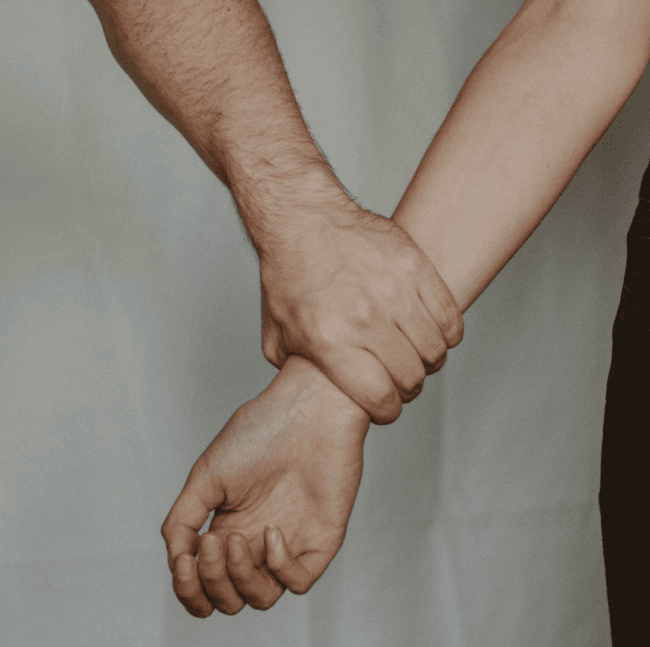In honor of Domestic Violence (DV) Awareness Month, Julia Hochstadt, a Clinical Social Worker for almost 25 years and has specialized in working with survivors of interpersonal violence, namely, domestic violence and sexual assault – life work that she truly loves. “To anyone who has been, is currently, or cares about someone who has experienced an abusive relationship, on behalf of survivors everywhere, I thank you for believing, supporting, and respecting those who have experienced domestic violence of any kind. You are not alone,” she says. Julia has shares about herself and has put together a guide to recognizing when someone is in a domestic violence relationship, what to do about it, how to talk about it, and resources to know.
I’m lucky enough to be one of those people who feels like I’ve never really worked a day in my life. At dinner parties and in casual conversation, hearing about my work often stops people in their tracks. “How do you love domestic violence?” Well, plain and simple, I love what I do because it’s a privilege to offer safe spaces for people to discuss some of their most private, painful experiences and help those same people heal.
Let’s start with the basics: the who, what, why, when, and how of domestic violence.

The Numbers
For starters, DV is surprisingly (because lots of people don’t discuss it) pervasive: 1 in 4 women and 1 in 7 men will experience some form of domestic violence in their lifetimes. These numbers astound me every time I say them out loud. However, these numbers only reflect those cases reported in some fashion, typically to a law enforcement agency of some kind.
And many, many people never choose to report their experience. The truth is, the actual rates of domestic violence are far greater than this. Think of yourself plus three friends. Or yourself plus three relatives. Or three neighbors. Or three other parents in your child’s class. That’s how pervasive DV is, based on reported cases alone.
What It Is
So what exactly IS domestic violence? Many people think of physical violence when it comes to DV. While this is sometimes the case in abusive relationships, it’s important to know that physical violence is not always present. Furthermore, there are actually five different categories of abusive behavior: they all count, and it’s up to the individual survivor to define what the “worst part” of what they might be experiencing is.
Read More: Local Women Produce Short Film About Domestic Violence
The five types of abusive behavior are physical, verbal, emotional/psychological, sexual, and financial. In each category, an abuser seeks to gain power and control over the other person, meaning all aspects of one’s unique and autonomous ability to make decisions and form opinions for themselves. An abusive person is looking to do this for you, in all ways, big and small.
Warning Signs
Everyone wants a list of warning signs when it comes to abusive relationships. These can be hard to come by, however, because “warning signs” like jealousy, wanting to spend tons of time together, or expressing opinions about one’s look or appearance, can be the very things that feel wonderful at the beginning of a new relationship.
It may be misrepresented early on as “this person likes me so much that they want to spend all our time together” or “the new person I’m seeing loves to compliment me when I wear certain things and really takes an interest in my appearance.”
Abusers generally don’t wear their “I’m an abusive person” T-shirts on a first date. Instead, these aspects of a person’s personality are typically revealed slowly and after building perceived trust with one another. Once a foundation has been established, a relationship, even an abusive one, can become much harder to leave.
For those of you who do well with lists, here goes. But it bears repeating that this list is certainly not all-inclusive and there are plenty of things on this list that, in and of themselves, may not represent partners behaving nicely but also do not – alone – indicate domestic violence. At the very least, these things warrant a good, hard think. You might have some concerns if your partner acts in any of the following ways towards you:
- – Controlling
- – Demeaning
- – Limiting of spending time with friends, family, work
- – Put-downs
- – Intense jealousy
- – Intimidating you through threats
- – Manipulating
- – Insulting, shaming, humiliating
- – Preventing you from making your own decisions
- – Controlling access to finances or financial decision-making
- – Sexual pressure
- – Pressure to use drugs or alcohol
- – Destroying your belongings
- – Preventing you from accessing your things, e.g. cell phone, clothing
Breaking It Down
Abusive behavior is all about, and only about, exerting power and control over another person. Violence in a relationship doesn’t happen because of jealousy, love, or intoxication. Sometimes these factors are present, but to be clear, they do not CAUSE abusive behavior.
Abusive behavior occurs because of choices made by an abusive partner, hard stop. And to clarify further, DV doesn’t discriminate: anyone can find themselves in an abusive relationship regardless of really any factors at all. Gender, age, socioeconomic status, race, religion, ethnicity, and educational background.
Abuse can take place at any time. Often, survivors will describe that abuse in their relationships unfolds in patterned ways, a phenomenon often referred to as the cycle of violence. This cycle refers to the ups and downs, ebbs and flows, times of abuse, and non-abuse in an abusive relationship. While no two relationships are the same, often this same pattern will emerge with time. For some abusive relationships, this pattern can take months or years to develop, and for others, days or weeks.
Abusive relationships will also “cycle through” both abusive and non-abusive times, which is one of the reasons why these relationships are so tough to leave because, like any other relationship, it’s not all good or all bad. As bad as abusive relationships can be and as compelling as these periods may be to end the relationship altogether, that’s as equally compelling as the good times may have a survivor feeling when things are good.
Because DV rates are so high, spontaneous disclosures can and do, happen all the time. You may be on the receiving end of disclosure from a friend, a family member, or a colleague. And the point here is, we never honestly know what’s happening in someone else’s home or their relationship unless we sleep under their bed at night. For many reasons, plenty of survivors do not discuss unhealthy relationship dynamics that they may be experiencing.
Abusers also have a knack for manipulating people around them, often behaving differently in public than they do behind closed doors. This phenomenon is known as “public face/private face” and is one of the many reasons why many survivors worry about not being believed. And again, just because something sounds unbelievable doesn’t mean it isn’t true.
See More: WomenRising: Dedicated to Domestic Violence Support + Local Families in Need
So how do you process a disclosure from a friend who says that their relationship is abusive? How do you offer them support? How do you handle your own fears or questions? You might feel unsure “how” to be there for them, “what” if anything you can or should say to them and most of all, feel unsure if talking about it at all would be helpful…or could make things worse.
Here’s a shortlist with tips on how to respond most effectively to a DV disclosure:
- – Believe a survivor when they disclose abuse. There is often little to no risk in believing, whereas leaving a survivor feeling not believed can stand in the way of them disclosing to others.
- – Listen in a non-judgmental manner; be aware of both verbal AND non-verbal communication.
- – Respect a survivor’s autonomy and remember people know how best to keep themselves safe; let them make their own decisions and remind them that they have power and control.
- – Acknowledge the abuse disclosure; if someone says something, let them know you heard them.
- – Provide information (e.g., resources for support) if you can.
- – Encourage the person to seek help if/when they feel ready or able to (remember, let them make their own decisions).
- – Support and empower the survivor however possible (e.g., “I’m here to support you, whatever you decide to do”).
- – Don’t make assumptions; remember that what works for you may not work best for them.
It is not easy to survive domestic violence. But it is also not easy to bear witness to someone else’s experience of abuse. During this Domestic Violence Awareness month, I encourage anyone who may be dealing with domestic violence in any form to find a safe space where you can process your experience and find the support that you so genuinely deserve. Remember, help is available and you are not alone.
North Jersey Resources
- Julia Hochstadt, LCSW: 212-613-6204 + 201-374-7444
- Safe Horizon DV Hotline: 1-800-621-HOPE (4673)
- National DV Hotline: 1-800-799-SAFE (7233)
- RAINN: 1-800-656-HOPE (4673)
- Suicide Prevention Hotline: 1-800-273-8255
- Morris County Family Justice Center
- Essex County Family Justice Center
- NYC Family Justice Centers
- NY Coalition Against Domestic Violence: (518) 482-5465
- NJ Coalition to end Domestic Violence: 1-800 572-7233









